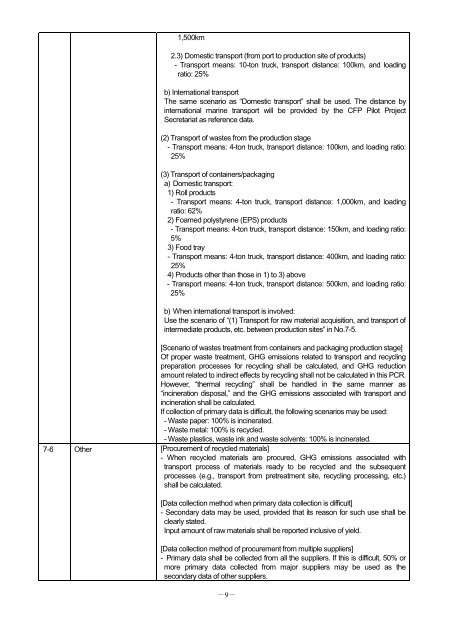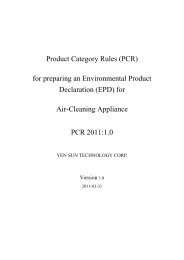Product Category Rules (PCR) - PCR Library
Product Category Rules (PCR) - PCR Library
Product Category Rules (PCR) - PCR Library
You also want an ePaper? Increase the reach of your titles
YUMPU automatically turns print PDFs into web optimized ePapers that Google loves.
1,500km<br />
2.3) Domestic transport (from port to production site of products)<br />
- Transport means: 10-ton truck, transport distance: 100km, and loading<br />
ratio: 25%<br />
b) International transport<br />
The same scenario as “Domestic transport” shall be used. The distance by<br />
international marine transport will be provided by the CFP Pilot Project<br />
Secretariat as reference data.<br />
(2) Transport of wastes from the production stage<br />
- Transport means: 4-ton truck, transport distance: 100km, and loading ratio:<br />
25%<br />
(3) Transport of containers/packaging<br />
a) Domestic transport:<br />
1) Roll products<br />
- Transport means: 4-ton truck, transport distance: 1,000km, and loading<br />
ratio: 62%<br />
2) Foamed polystyrene (EPS) products<br />
- Transport means: 4-ton truck, transport distance: 150km, and loading ratio:<br />
5%<br />
3) Food tray<br />
- Transport means: 4-ton truck, transport distance: 400km, and loading ratio:<br />
25%<br />
4) <strong>Product</strong>s other than those in 1) to 3) above<br />
- Transport means: 4-ton truck, transport distance: 500km, and loading ratio:<br />
25%<br />
b) When international transport is involved:<br />
Use the scenario of “(1) Transport for raw material acquisition, and transport of<br />
intermediate products, etc. between production sites” in No.7-5.<br />
[Scenario of wastes treatment from containers and packaging production stage]<br />
Of proper waste treatment, GHG emissions related to transport and recycling<br />
preparation processes for recycling shall be calculated, and GHG reduction<br />
amount related to indirect effects by recycling shall not be calculated in this <strong>PCR</strong>.<br />
However, “thermal recycling” shall be handled in the same manner as<br />
“incineration disposal,” and the GHG emissions associated with transport and<br />
incineration shall be calculated.<br />
If collection of primary data is difficult, the following scenarios may be used:<br />
- Waste paper: 100% is incinerated.<br />
- Waste metal: 100% is recycled.<br />
- Waste plastics, waste ink and waste solvents: 100% is incinerated.<br />
7-6 Other [Procurement of recycled materials]<br />
- When recycled materials are procured, GHG emissions associated with<br />
transport process of materials ready to be recycled and the subsequent<br />
processes (e.g., transport from pretreatment site, recycling processing, etc.)<br />
shall be calculated.<br />
[Data collection method when primary data collection is difficult]<br />
- Secondary data may be used, provided that its reason for such use shall be<br />
clearly stated.<br />
Input amount of raw materials shall be reported inclusive of yield.<br />
[Data collection method of procurement from multiple suppliers]<br />
- Primary data shall be collected from all the suppliers. If this is difficult, 50% or<br />
more primary data collected from major suppliers may be used as the<br />
secondary data of other suppliers.<br />
-9-















